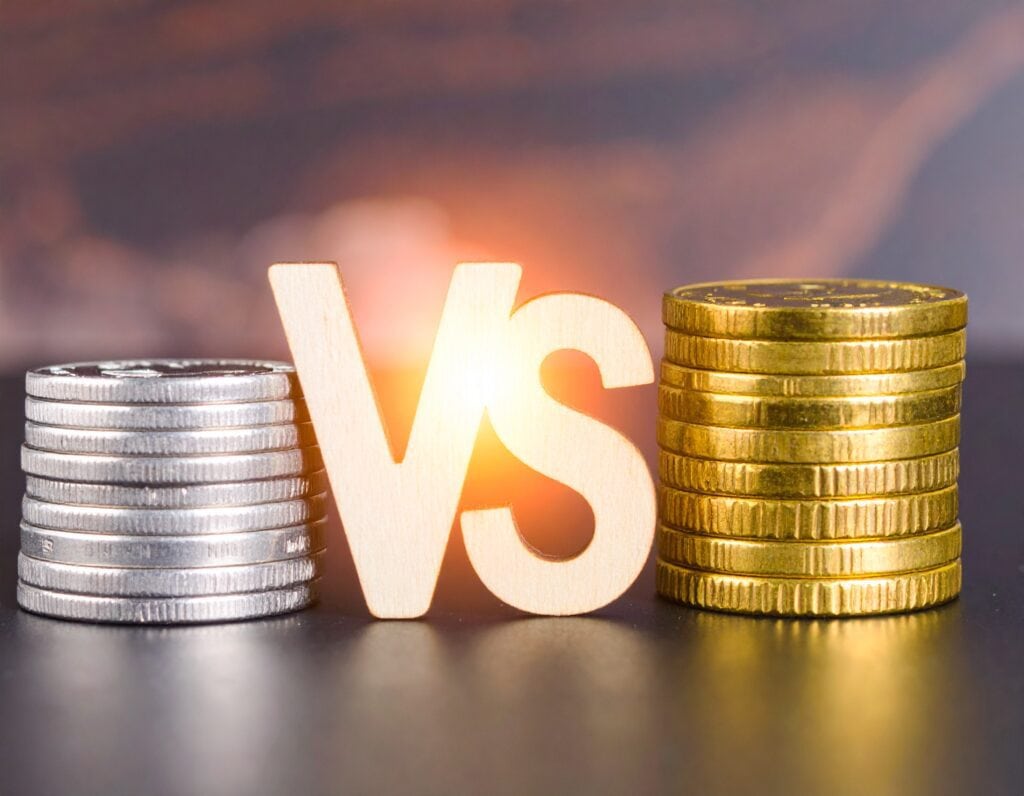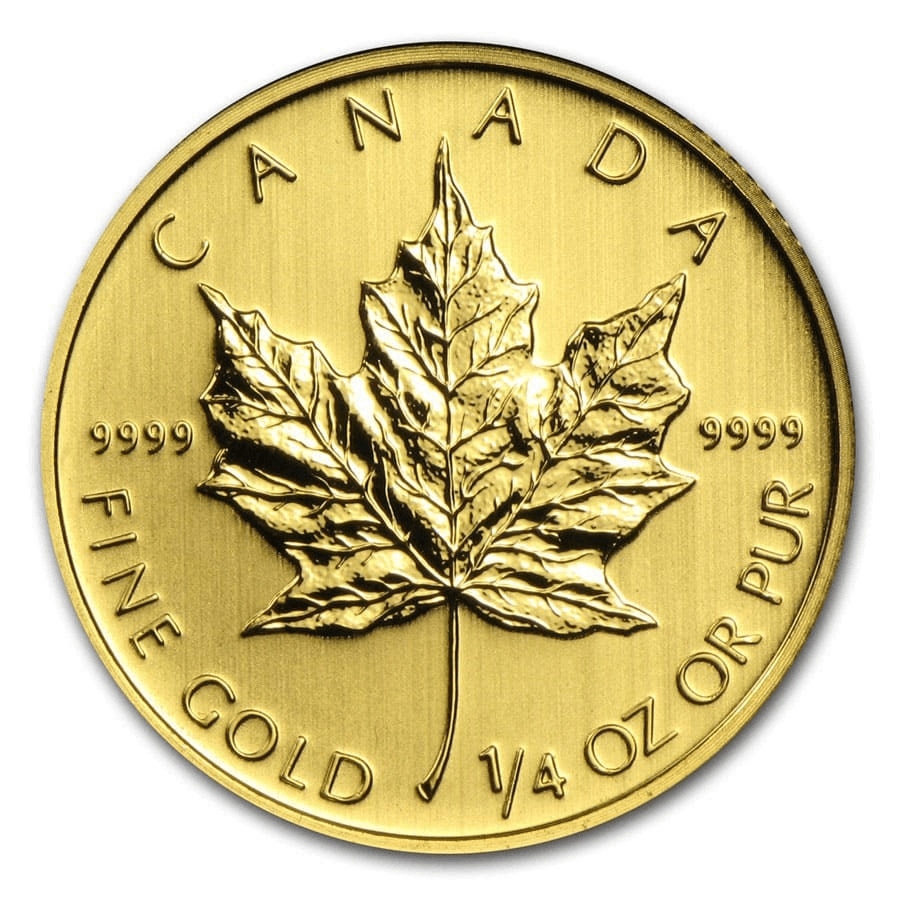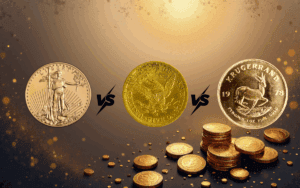New precious metals investors usually choose between silver and gold coins. Silver costs less upfront while gold stores more value per coin. The first purchase decision you make can shape your entire investment strategy.
Key Differences Between Gold and Silver Coins
- Silver offers lower entry costs making it ideal for beginners with smaller budgets
- Gold provides higher value concentration and better long-term wealth preservation
- Silver requires more storage space due to it’s lower value
- Both serve as hedges against inflation and currency devaluation
- Starting with silver then adding gold creates a balanced approach for investors
Budget Considerations for Beginners
Silver costs significantly less than gold coins. A one-ounce American Gold Eagle costs $3,398–$3,511 according to Business Insider’s gold price chart and an American Silver Eagle costs $38–$42 per Monex’s silver price chart.
This price difference affects buying frequency. Monthly $120 investments buy three silver coins versus waiting years for one gold coin.
Gold offers higher value density than silver coins. This advantage matters most when storage space is limited.
One ounce of gold holds roughly 80-85 times the value of silver at current ratios. Silver’s lower cost allows more frequent purchases, helping beginners learn about premiums and dealer relationships with smaller financial risk. Your first coin purchase will feel less intimidating at $40 versus $3,400.
Storage Space and Security Concerns
Storage requirements differ significantly between silver coins and gold coins.
Silver takes much more space than gold. Storing $5,000 in silver requires about 132 oz of bullion coins, whereas the same value in gold requires only 1.45 oz.
Home storage considerations include:
- Silver requires larger safes or storage solutions
- Gold is easier to conceal and transport discreetly
- Both precious metals need protection from moisture and handling damage
- Professional storage fees often scale with volume, making silver proportionally more expensive
New investors typically start with small home safes for silver, then consider professional vault storage as holdings grow.

Liquidity and Resale Value Comparison
Silver and gold coins have strong market acceptance with practical selling differences.
Government-minted coins like American Eagles, Canadian Maples, and Austrian Philharmonics are widely recognized by dealers nationwide. Gold offers better liquidity for larger transactions. Converting $10,000 in precious metals means handling three gold coins versus around 260 silver coins.
Premiums differ between silver and gold coins. Silver coins typically trade at 12–20% over spot, while gold coins generally carry 5–10% premiums over the market price.
This means gold delivers more actual metal per investment dollar. Since premiums vary by dealer, shopping around becomes important. Most established precious metals dealers stock both metals, though local coin shops may specialize in one metal.
Gold’s higher unit value means fewer transactions and less paperwork when selling. Silver sales involve more pieces and take longer to process.
Volatility and Risk Differences
Price behavior differs significantly between gold and silver coins.
Silver prices are more volatile than gold. During the 2020 market rally (March to August 2020), silver jumped from $12 to over $28 per ounce while gold rose from $1,472 to $2,067. Silver more than doubled while gold gained about 40%. This pattern repeats – silver climbs higher during good times but falls harder during market stress.
Gold offers more predictable price fluctuations. Gold’s stability comes from its role as a store of wealth rather than an industrial commodity. Silver faces different pressures because half its demand comes from electronics, solar panels, and medical devices.

Industrial demand affects silver investors differently. Economic growth raises silver prices when industries need more metal, but recessions push prices down when industrial demand falls. Gold avoids these industrial swings.
Both metals protect against inflation, but they don’t always move together. This helps diversification. Experienced investors trade between the metals when their price ratio shifts.
Choosing Your First Coins
Most beginners start with silver, then add gold as their investment knowledge and portfolio grows. Silver’s lower cost makes this progression financially practical for most budgets.

Why Begin with Silver?
- Lower cost lets you start immediately without saving up
- Easier to make regular purchases and build buying habits
- Less financial stress if you make beginner mistakes
- Better for learning about dealer relationships and market timing
- More affordable way to understand premiums and storage needs
When to Add Gold?
- Once you’re comfortable with the precious metals buying process
- When you have larger amounts to invest ($1,000+ at a time)
- If storage space becomes a limiting factor
- As your portfolio grows and you want more value concentration
Most new investors buy 1-3 silver coins monthly for 6-12 months, then add gold coins quarterly. This approach allows gradual market learning with smaller financial commitments.
Starting small also helps you understand dealer differences, premium variations, and storage requirements before making larger investments.
Budget, storage capacity, and risk tolerance determine which metal works for your initial purchase.
Make Your Choice with Expert Guidance
Whether you choose gold or silver for your first purchase, GR Reserve brings over 100 years of precious metals expertise to guide your investment decisions. As a family-owned business since 1915, we offer the most competitive prices in the industry while bringing products once exclusive to wholesalers directly to retail investors.
Contact us today to discuss which coins work best for your budget and investment goals.




